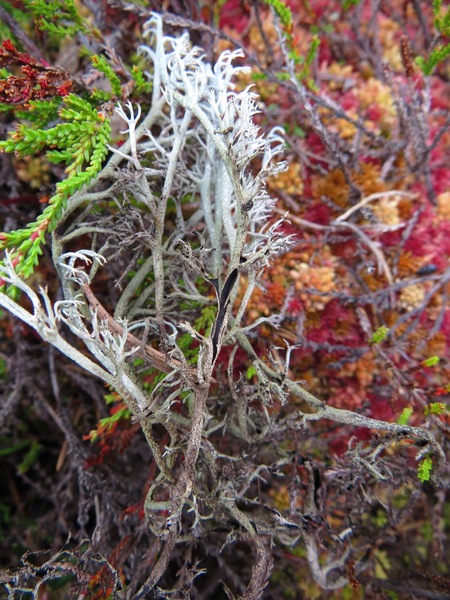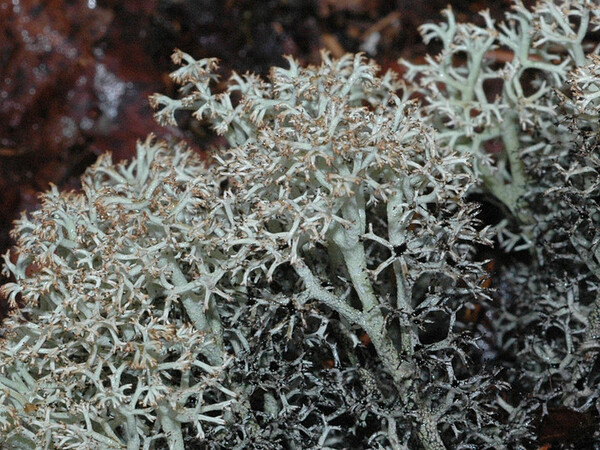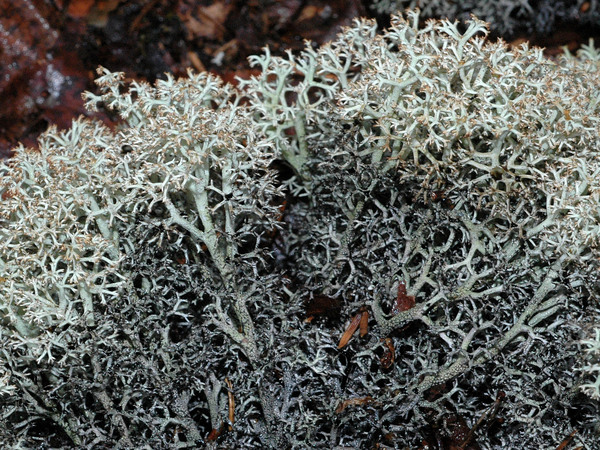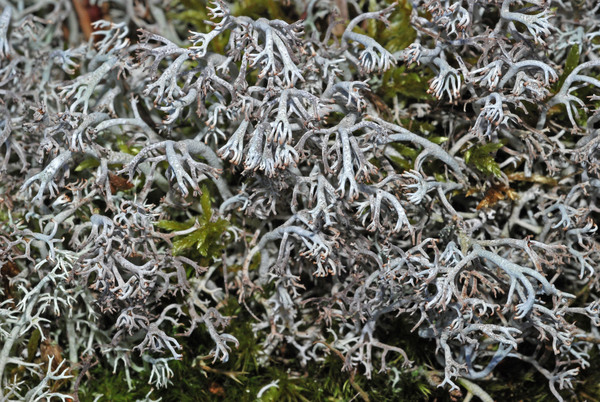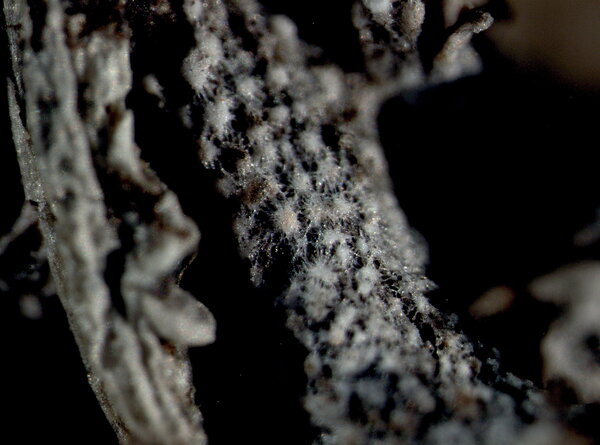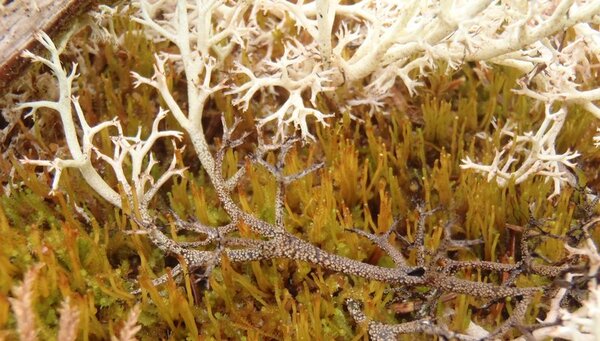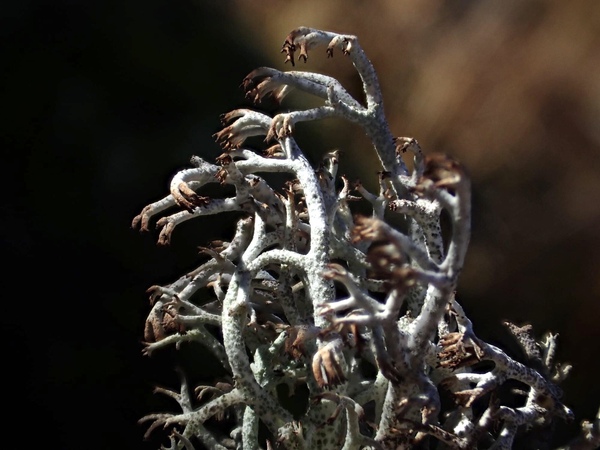Cladonia stygia (Fr.) Ruoss
Botanica Helvetica, 95: 241, 1985. Basionym: Cladonia rangiferina f. stygia Fr. - Nov. Sched. Crit. Lich. Suec., 8-9, 3: 22, 1826.
Synonyms: Cladina stygia (Fr.) Ahti
Distribution:
Description: Primary thallus crustose, ephemeral, usually not visible. Podetia shrubby, hollow inside, ash-grey to bluish-grey, loosely attached and dying from the base, anisotomically (i.e. main branches thicker) tri- tetrachotomously branched, 4-10 cm tall, to 1(-2) mm thick, the surface esquamulose, ecorticate and minutely arachnoid; terminal branchlets divaricate or unilaterally deflexed, situated around an open or rarely closed axil; algal layer continuous, except at base, where it give rise to characteristic white areoles scattered over the melanotic medulla. Inner part of the main branches coal-black from the base to at least the first ramifications. Apothecia rare, terminal, brown, convex. Asci 8-spored, clavate, thickened at apex, with a K/I+ blue tholus and a K/I+ strongly blue outer gelatinous sheath, Cladonia-type. Ascospores 1-celled, hyaline, ellipsoid. Pycnidia dark, semi-immersed, on the tips of podetia, with a reddish jelly. Conidia hyaline, curved. Photobiont chlorococcoid, Spot tests: K+ yellow sometimes slowly turning brown, C-, KC-, P+ red, UV-. Chemistry: atranorin and fumarprotocetraric acid complex.Note: a very rare, probably declining species of subalpine Sphagnum-bogs. To be looked for in the Italian Alps.
Growth form: Fruticose
Substrata: soil, terricolous mosses, and plant debris
Photobiont: green algae other than Trentepohlia
Reproductive strategy: mainly asexual, by thallus fragmentation
Commonnes-rarity: (info)
Alpine belt: absent
Subalpine belt: absent
Oromediterranean belt: absent
Montane belt: absent
Submediterranean belt: absent
Padanian area: absent
Humid submediterranean belt: absent
Humid mediterranean belt: absent
Dry mediterranean belt: absent

Predictive model
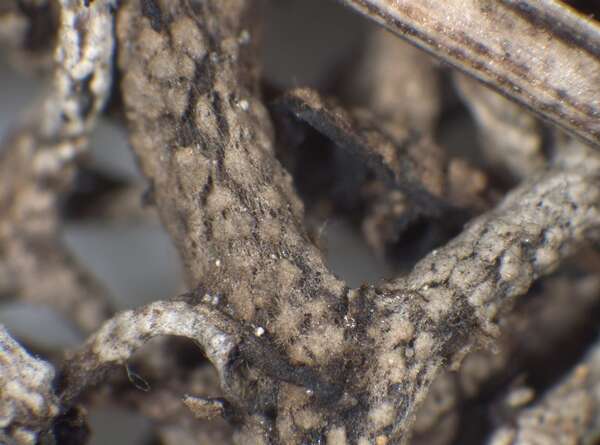

P.L. Nimis; Owner: Department of Life Sciences, University of Trieste
Herbarium: TSB (8244)
2003/03/12
detail of the basis of podetium
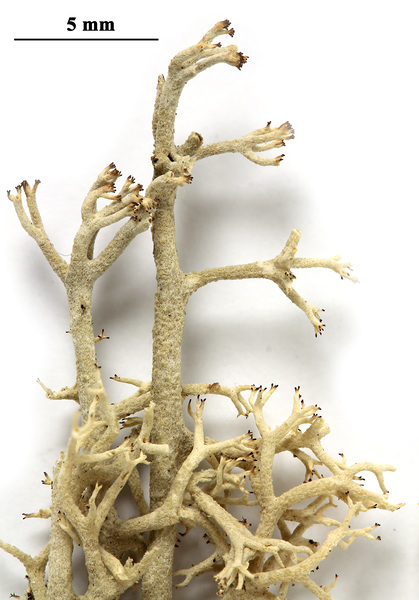
Felix Schumm- CC BY-SA 4.0
[15712], Canada. 49° 32.143' N, 92° 8.287' W. Junction of Highways #17 & 622, Ontario; 421 m. Leg. S.A. Harris 28. Juni 2004 (Nr. 4225), det. S.A. Harris.
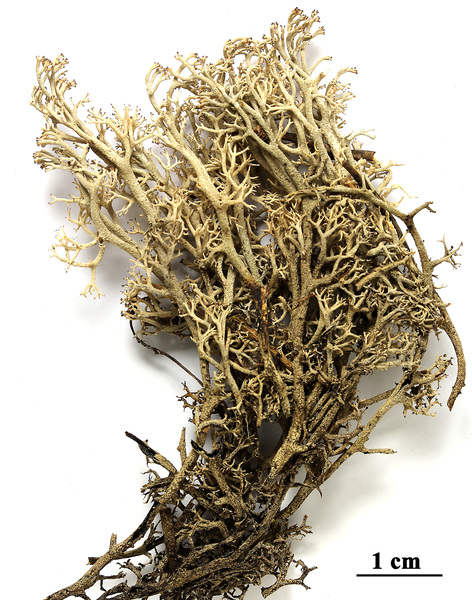
Felix Schumm- CC BY-SA 4.0
[15712], Canada. 49° 32.143' N, 92° 8.287' W. Junction of Highways #17 & 622, Ontario; 421 m. Leg. S.A. Harris 28. Juni 2004 (Nr. 4225), det. S.A. Harris.


Felix Schumm - CC BY-SA 4.0
[20293], Finland, Koillismaa, Kuusamo, Kurvinen, ca. 3 km SE of Korpijärvi, SW shore of Hanhilampi, large, open fen (eutrophic). 27° E, 727:62. Leg. et det. T. Ahti (Nr. 20870a), 8.8.1965. Dubl. ex Museum Botanicum Universitatis Helsinki.
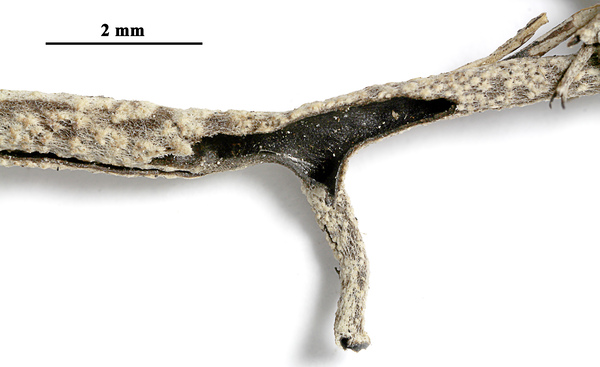

Felix Schumm - CC BY-SA 4.0
[20293], Finland, Koillismaa, Kuusamo, Kurvinen, ca. 3 km SE of Korpijärvi, SW shore of Hanhilampi, large, open fen (eutrophic). 27° E, 727:62. Leg. et det. T. Ahti (Nr. 20870a), 8.8.1965. Dubl. ex Museum Botanicum Universitatis Helsinki.
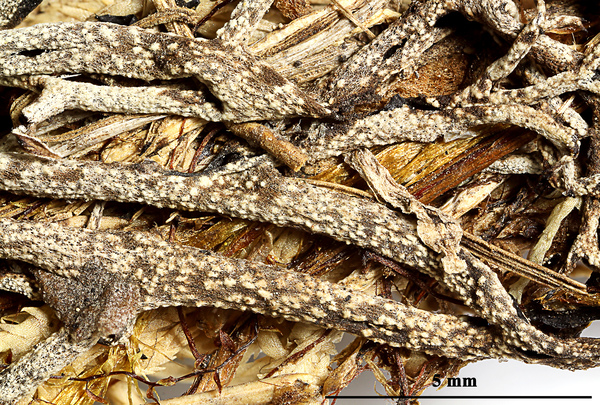

Felix Schumm - CC BY-SA 4.0
[20293], Finland, Koillismaa, Kuusamo, Kurvinen, ca. 3 km SE of Korpijärvi, SW shore of Hanhilampi, large, open fen (eutrophic). 27° E, 727:62. Leg. et det. T. Ahti (Nr. 20870a), 8.8.1965. Dubl. ex Museum Botanicum Universitatis Helsinki.


Felix Schumm - CC BY-SA 4.0
[20293], Finland, Koillismaa, Kuusamo, Kurvinen, ca. 3 km SE of Korpijärvi, SW shore of Hanhilampi, large, open fen (eutrophic). 27° E, 727:62. Leg. et det. T. Ahti (Nr. 20870a), 8.8.1965. Dubl. ex Museum Botanicum Universitatis Helsinki.
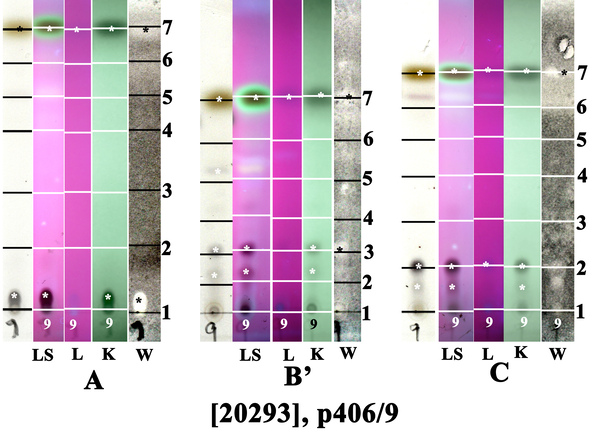

Felix Schumm - CC BY-SA 4.0
[20293], Finland, Koillismaa, Kuusamo, Kurvinen, ca. 3 km SE of Korpijärvi, SW shore of Hanhilampi, large, open fen (eutrophic). 27° E, 727:62. Leg. et det. T. Ahti (Nr. 20870a), 8.8.1965. Dubl. ex Museum Botanicum Universitatis Helsinki.
at: atranorin, f: fumarprotocetraric acid (maj), p: protocetraric acid (min)
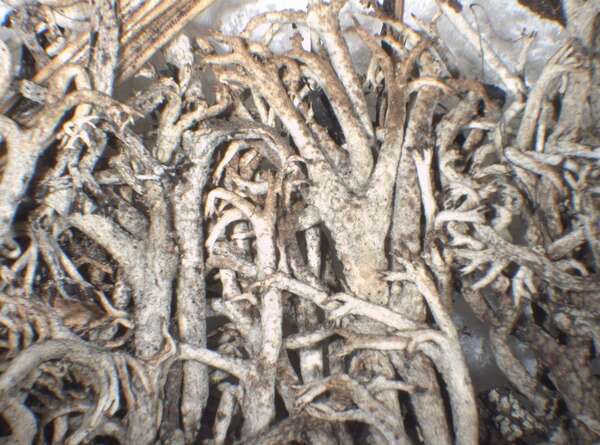

P.L. Nimis; Owner: Department of Life Sciences, University of Trieste
Herbarium: TSB (8244)
2003/03/12
Growth form: Fruticose
Substrata: soil, terricolous mosses, and plant debris
Photobiont: green algae other than Trentepohlia
Reproductive strategy: mainly asexual, by thallus fragmentation
Commonnes-rarity: (info)
Alpine belt: absent
Subalpine belt: absent
Oromediterranean belt: absent
Montane belt: absent
Submediterranean belt: absent
Padanian area: absent
Humid submediterranean belt: absent
Humid mediterranean belt: absent
Dry mediterranean belt: absent

Predictive model


P.L. Nimis; Owner: Department of Life Sciences, University of Trieste
Herbarium: TSB (8244)
2003/03/12
detail of the basis of podetium

Felix Schumm- CC BY-SA 4.0
[15712], Canada. 49° 32.143' N, 92° 8.287' W. Junction of Highways #17 & 622, Ontario; 421 m. Leg. S.A. Harris 28. Juni 2004 (Nr. 4225), det. S.A. Harris.

Felix Schumm- CC BY-SA 4.0
[15712], Canada. 49° 32.143' N, 92° 8.287' W. Junction of Highways #17 & 622, Ontario; 421 m. Leg. S.A. Harris 28. Juni 2004 (Nr. 4225), det. S.A. Harris.


Felix Schumm - CC BY-SA 4.0
[20293], Finland, Koillismaa, Kuusamo, Kurvinen, ca. 3 km SE of Korpijärvi, SW shore of Hanhilampi, large, open fen (eutrophic). 27° E, 727:62. Leg. et det. T. Ahti (Nr. 20870a), 8.8.1965. Dubl. ex Museum Botanicum Universitatis Helsinki.


Felix Schumm - CC BY-SA 4.0
[20293], Finland, Koillismaa, Kuusamo, Kurvinen, ca. 3 km SE of Korpijärvi, SW shore of Hanhilampi, large, open fen (eutrophic). 27° E, 727:62. Leg. et det. T. Ahti (Nr. 20870a), 8.8.1965. Dubl. ex Museum Botanicum Universitatis Helsinki.


Felix Schumm - CC BY-SA 4.0
[20293], Finland, Koillismaa, Kuusamo, Kurvinen, ca. 3 km SE of Korpijärvi, SW shore of Hanhilampi, large, open fen (eutrophic). 27° E, 727:62. Leg. et det. T. Ahti (Nr. 20870a), 8.8.1965. Dubl. ex Museum Botanicum Universitatis Helsinki.


Felix Schumm - CC BY-SA 4.0
[20293], Finland, Koillismaa, Kuusamo, Kurvinen, ca. 3 km SE of Korpijärvi, SW shore of Hanhilampi, large, open fen (eutrophic). 27° E, 727:62. Leg. et det. T. Ahti (Nr. 20870a), 8.8.1965. Dubl. ex Museum Botanicum Universitatis Helsinki.


Felix Schumm - CC BY-SA 4.0
[20293], Finland, Koillismaa, Kuusamo, Kurvinen, ca. 3 km SE of Korpijärvi, SW shore of Hanhilampi, large, open fen (eutrophic). 27° E, 727:62. Leg. et det. T. Ahti (Nr. 20870a), 8.8.1965. Dubl. ex Museum Botanicum Universitatis Helsinki.
at: atranorin, f: fumarprotocetraric acid (maj), p: protocetraric acid (min)


 Index Fungorum
Index Fungorum
 GBIF
GBIF
